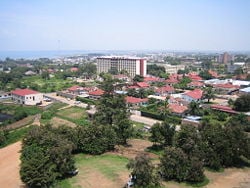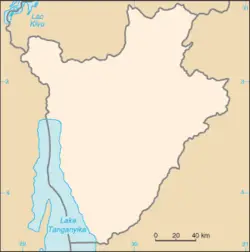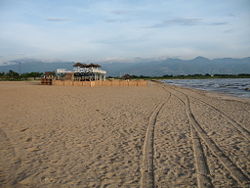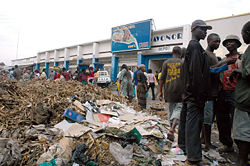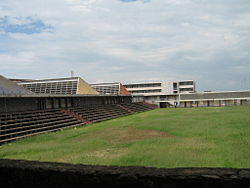Bujumbura
| Bujumbura, Burundi | |
| Central Bujumbura, with Lake Tanganyika in the background | |
| Coordinates: {{#invoke:Coordinates|coord}}{{#coordinates:3|23|00|S|29|22|00|E|type:city | |
|---|---|
| name= }} | |
| Province | Bujumbura-Ville |
| Population (1994) | |
| - City | 300,000 |
| - Urban | 300,000 |
| estimated | |
| Time zone | CAT (UTC+1) |
| - Summer (DST) | none (UTC+1) |
Bujumbura (pronounced /ˌbuːdʒəmˈbuːrə/), the capital city of Burundi, and is Burundi's largest city and its administrative, communications, and economic center.
Geography
Etymology of name – if available. Burundi, a landlocked country, lies on a rolling plateau, with Lake Tanganyika in its southwest corner. Bujumbura lies at the northeastern corner of the lake, at an elevation of 2605 feet (794 meters). Mount Karonje, at 8809 feet (2685 meters), lies to the southeast of the capital.
Burundi has a tropical highland climate. Bujumbura's average annual temperature is 25°C (78°F), without much seasonal variation, but with slightly cooler minimums in July. Rain is irregular. Four seasons can be distinguished; the long dry season (June - August); the short west season (September-November), the short dry season (December-January) and the long wet season (February- May). Total mean annual rainfall is 33.3 inches (848mm).
Environmental issues involve soil erosion, as a result of overgrazing and the expansion of agriculture into marginal lands; deforestation resulting from uncontrolled cutting of trees for fuel; and habitat loss, which threatens wildlife populations.
The city center is a colonial town with a large market, the national stadium, a large mosque, and the cathedral for the Archdiocese of Bujumbura.
History
Bujumbura grew from a small village after it became a military post in German East Africa in 1889. After World War I it was made the administrative center of the Belgian League of Nations mandate of Ruanda-Urundi. The city's name was changed from Usumbura to Bujumbura when Burundi became independent in 1962. Since independence, Bujumbura has been the scene of frequent fighting between the country's two main ethnic groups, with Hutu militias opposing the Tutsi-dominated Burundi army.
The city was the center of an ethnically inspired civil war in the 1990s and early 21st century.
Government
Burundi is a republic. The president, who is elected by popular vote to a five-year term and is eligible for a second term, is both the chief of state and head of government. The bicameral parliament consists of a national assembly with a minimum of 100 seats, of which 60 percent must be Hutu and 40 percent Tutsi, with at least 30 percent being women, and with additional seats appointed by a National Independent Electoral Commission to ensure ethnic representation. Members are elected by popular vote to serve five-year terms. A and with remaining seats assigned to ethnic groups and former chiefs of state.
Burundi is divided into 17 provinces, 117 communes, and 2,638 colonies. The capital city, Bujumbura, has by far the largest population. Smaller cities include Gitega, Muyinga, Ngozi, and Ruyigi.
Economy
Burundi is a landlocked, resource-poor country with an underdeveloped manufacturing sector. The economy is predominantly agricultural with more than 90 percent of the population dependent on subsistence agriculture. Economic growth depends on coffee and tea exports, which account for 90 percent of foreign exchange earnings. The ability to pay for imports rests primarily on weather conditions and international coffee and tea prices. The Tutsi minority, 14 percent of the population, dominates the government and the coffee trade at the expense of the Hutu majority, 85 percent of the population. Per capita GDP was estimated at $US400 in 2007.
Bujumbura is Burundi's main port and ships most of the country's chief export, coffee, as well as cotton, skins, and tin ore.
Agricultural produce grown in the surrounding area includes bananas, cassava (manioc), beans, corn (maize), wheat, and cotton. The city's industry involves textiles, soap, leather, paper, chemicals, and agricultural products.
Ferries sail from Bujumbura to Kigoma in Tanzania, while the city is also home to the Bujumbura International Airport.
Demography
Bujumbura had an estimated population of 300,000 in 1994. Population = 187,297
Regarding Burundi's ethnic composition, Hutu (Bantu) make up 85 percent of the population, Tutsi (Hamitic) 14 percent, and Twa (Pygmy) one percent. There were 3000 Europeans, and 2000 South Asians there in 2008.
Kirundi and French are both official languages, while Swahili is spoken in the Bujumbura area.
Christians make up 67 of the population (Roman Catholic 62 percent, Protestant 5 percent), those adhering to indigenous beliefs make up 23 percent, and Muslims 10 percent.
The city is home to the University of Bujumbura. Its facilities are deteriorating and significantly damaged due to an ongoing civil war. In its infancy, it was owned and operated by the Roman Catholic Church. Its 2008 enrollment was approximately 3124. It focuses on training personnel required by the civil service.
Of interest
Museums in the city include the Burundi Museum of Life and the Burundi Geological Museum. Other nearby attractions include the Rusizi National Park, the Livingstone-Stanley Monument at Mugere (where David Livingstone and Henry Morton Stanley visited 14 days after their first historic meeting at Ujiji in Tanzania), and the source of the southernmost tributary of the Nile, described locally as the source of the Nile.
The city is also where a lot of the Disney movie George of the Jungle is supposed to take place (though the film's location bears very little resemblance to the real city).
ReferencesISBN links support NWE through referral fees
- Dickerman, Carol Wilson. 1983. "The founding of Bujumbura". Culture Et Société : Revue De Civilisation Burundaise. (6): 35-65. OCLC 40185451
- Dickerman, Carol Wilson. 1988. Urban housing and land markets: Bujumbura, Burundi. [Madison, Wis.]: Land Tenure Center, University of Wisconsin-Madison. OCLC 19368406
- Nkolo, Antoine. 2002. "Bujumbura: gateway to Africa's Switzerland". Selamta. 19.
OCLC 174115565
- World Fact Book 2008 Burundi Retrieved August 12, 2008.
- Encyclopaedia Britannica Bujumbura Retrieved August 12, 2008.
External links
Official Bujumbura's Website www.villedebujumbura.org
Credits
New World Encyclopedia writers and editors rewrote and completed the Wikipedia article in accordance with New World Encyclopedia standards. This article abides by terms of the Creative Commons CC-by-sa 3.0 License (CC-by-sa), which may be used and disseminated with proper attribution. Credit is due under the terms of this license that can reference both the New World Encyclopedia contributors and the selfless volunteer contributors of the Wikimedia Foundation. To cite this article click here for a list of acceptable citing formats.The history of earlier contributions by wikipedians is accessible to researchers here:
The history of this article since it was imported to New World Encyclopedia:
Note: Some restrictions may apply to use of individual images which are separately licensed.
